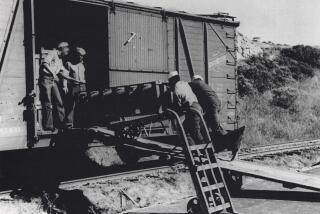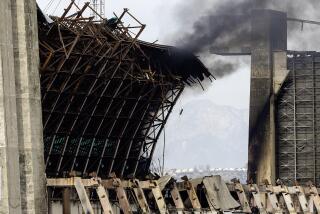U.S. to Aid WWII Poison Gas Test Victims : Health: As many as 60,000 servicemen may have been exposed in studies on protective gear. Government had fought disability claims for years.
- Share via
WASHINGTON — Fifty years after the Navy exposed hundreds of young sailors to poisonous gases in a Washington research laboratory, the federal government acknowledged that the servicemen may have suffered serious, long-term disabilities. After years of fighting their claims, the government Tuesday offered them compensation.
“These fellows were treated unfairly,” said Anthony J. Principi, deputy secretary of veterans affairs, who said that as many as 60,000 servicemen may have been exposed to the gases in experiments that were conducted in Maryland, Utah and Illinois, as well as in Washington.
The Washington tests, designed to gauge the effectiveness of protective gear, may have been the most severe. In all, about 2,000 sailors volunteered for what were described as “full-body exposure” tests at the Naval Research Laboratory that began in 1941 and continued through World War II.
The sailors, most of them ages 17 to 19, were told only that they would be testing “summer clothing” and were promised weekend passes in return. They were placed in a gas chamber and exposed to various amounts of mustard gas and lewisite gas, a poisonous gas made from arsenic. Some sailors returned to the chamber for as long as an hour a day, six days a week, although it was unclear how many weeks they participated.
After World War I, most nations agreed not to use poison gases in war, although Iraq used mustard gas during its war against Iran in the 1980s and later against its own Kurdish population. Iraq did not use it during the 43-day Persian Gulf War, as coalition forces had feared it might.
For many sailors in the World War II experiments, the gas masks and the protective gear proved ineffective. Those burned by the gases were told to describe their injuries as sunburn. All were cautioned not to discuss the tests with anyone, including their doctors, on the pain of a court-martial.
Because of the secret nature of the tests and the paucity of medical records kept on the experiments, it was “impossible” for any of the veterans to prove they had been injured by the experiments, said Rep. Porter J. Goss (R-Fla.), who began championing the issue two years ago.
After years of opposing the claims and faced with the prospect of an expose by CBS-TV’s “60 Minutes” that has not yet aired, the department Tuesday announced that it would impose new rules that should make it easier for the servicemen to win benefits. “Because of the confidential nature of some mustard gas testing during World War II, we are giving the benefit of the doubt to those veterans who were involved in the tests,” said VA Secretary Edward J. Derwinski.
Principi said the VA would attempt to find the sailors exposed to the tests. Tracking the veterans will be difficult because Navy test logs often failed to fully identify the sailors, VA spokesman Dennis Boxx said.
The VA announcement was a victory for Goss, who had pressed Congress to approve special legislation that would grant $750,000 to four veterans who have claimed they are disabled as a result of the tests. Goss said the Navy acknowledged in the 1970s that it had conducted the tests but it had taken years after that for many of the veterans to verify that they were among those exposed.
Normally, the VA requires veterans seeking compensation to show that they suffered a disabling injury or illness during their period of active duty. Under the rules announced Tuesday, any veteran who was exposed to the gases and now suffers from laryngitis, chronic bronchitis, emphysema, asthma, chronic conjunctivitis or corneal opacities will not have to produce evidence that they may have contracted the illness while in uniform.
In addition, Principi said the VA was seeking a study by the National Academy of Sciences into other ailments that may been caused by the gases.
More to Read
Sign up for Essential California
The most important California stories and recommendations in your inbox every morning.
You may occasionally receive promotional content from the Los Angeles Times.










